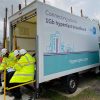Lords Report Propose Fixes for Poor UK Rural Broadband and Mobile
A new cross-party report from the House of Lords Select Committee on the Rural Economy has warned that rural communities across the UK are still being “ignored and underrated,” with many still suffering from poor fixed line broadband ISP and mobile network connectivity. But they also recommend some possible solutions.
At present around 96% of premises can access a fixed “superfast broadband” (24Mbps+) service, which is partly thanks to the £1.7bn+ state aid funded Broadband Delivery UK project. Similarly Ofcom’s recent Connected Nations 2018 report found that the outdoor geographic coverage of 4G services across the UK is still painfully low at 66% (up from 43% a year earlier) from all four mobile operators or 91% from at least one operator (EE).
In fairness we expect BDUK to help further extend superfast broadband to cover over 97% of premises by March 2020. The Government has similarly committed to extend geographic mobile cover to 95% of the UK by 2022 and Ofcom’s future auction of the 700MHz mobile band will come attached to new obligations (here), but those will only extend outdoor 4G or 5G data coverage to at least 90% of the UK’s entire land area within 4 years of the award.
Advertisement
Naturally the bits that get missed out by these targets predominantly tend to reflect a good number of often remote and sparse rural communities, such as hill farmers and tiny villages. So far the main connectivity solution that has been developed to tackle this is the forthcoming Universal Service Obligation (USO), which upon request will aim to deploy a 10Mbps or faster broadband service within 12 months (starting end of 2019).
The Government are also adopting an “outside-in” approach to deployment of future Gigabit “full fibre” (FTTP) broadband networks under the Future Telecoms Infrastructure Review (i.e. tackling rural areas at the same time as urban ones) and forthcoming rural Gigabit broadband voucher scheme. But it will still take many years and billions more in public investment in order to achieve the plan for “nationwide” coverage by 2033.
What more could be done?
The question thus becomes, what more could be done to help those rural communities that are likely to be waiting a long time for something better than the broadband USO or decent 4G / 5G mobile coverage. It’s a question that is frequently asked (here, here and here) but one that is rarely answered with much concrete detail.
Lord Foster of Bath, Chair of the Committee, said:
“Rural communities and the economies in them have been ignored and underrated for too long. We must act now to reverse this trend, but we can no longer allow the clear inequalities between the urban and rural to continue unchecked.
A rural strategy would address challenges and realise potential in struggling and under-performing areas, and allow vibrant and thriving areas to develop further. Doing nothing is not an option.”
As part of this the committee has proposed a series of recommendations, which we’ll list and then examine. The crux of all this appears to centre around a call for mobile roaming in UK rural areas and an increase to the £3,400 cost threshold for the USO (inc. review of the USO speed).
Advertisement
The Recommendations
* DCMS and Ofcom should also identify what further actions are necessary to address poor mobile connectivity in areas unlikely to benefit from the spectrum auction.
* Ofcom must improve access to information about digital connectivity. This should include regularly updated information about when residents and businesses can expect to be connected to digital infrastructure, connectivity options for communities and details of providers operating in their local area, and regular reporting on the progress of 5G rollout in local areas.
* We welcome the principle of the USO which will give people in the UK the right to request a decent broadband connection. However, we believe the upload and download speeds are too modest in the USO commitment and should be reviewed along with the £3,400 payment threshold so that rural homes and businesses are not excluded. Ofcom has a duty to review the USO if directed to do so by the Government.
* While we recognise that Ofcom has updated their aggregate statistics on rural mobile coverage better to align with consumer experience, we believe it should be required to develop an accurate evidence base for consumers about phone coverage in specific locations. Without this, it is not possible to identify the full scale of the problem or to assess how best to go about fixing it.
* We welcome the proposal that Ofcom should review the option of introducing roaming in rural areas to address partial not-spots and would urge Ofcom to begin this review as a matter of urgency. Government and Ofcom should also encourage mobile network operators to share transmission masts more often at locations where they offer a practical means to improve rural connectivity. Mast sites should nonetheless be chosen sensitively, especially in areas of high landscape value.
* Local and national governments must do more to realise the potential of improving digital skills in rural areas, including supporting the establishment of digital enterprise hubs; promoting networking opportunities; facilitating knowledge sharing and the dissemination of good practice among rural businesses; and enabling more effective IT support for small rural businesses and start-ups.
The idea of Rural Roaming is simple enough. Essentially, whenever you pass into a rural area where your mobile operator can’t receive a service then the signal would be allowed to roam onto another operator’s network (like when you go abroad), where a service may still be present. Technically difficult but certainly possible.
However rural roaming is not particularly popular among operators that have investment the most in building their networks into challenging rural areas (e.g. EE). This is because it effectively gives a free ride to rivals who haven’t made the same investment, thus removing a competitive advantage and stifling the attraction of future such investments (extending rural cover isn’t very profitable).
Instead mobile operators are currently debating a different approach of mutually beneficial mast sharing in areas of only partial coverage (i.e. sharing of mast space for radio kit, provided this is reciprocated by both sides – Ofcom acting as referee).
Getting the details right for mast sharing will be difficult but this does represent one partial solution (here), although we think allowing taller masts should also be considered. However doing that without local opposition has often proven to be quite difficult (here), which is despite the fact that one tall mast could mean the removal of several smaller ones (we already allow much more imposing wind turbines).
Advertisement
As for the USO’s cost threshold, it’s worth remembering that this is an industry funded initiative and some properties are so remote that connecting them may cost tens or even hundreds of thousands of pounds. Suffice to say that you’d have to raise the cost threshold quite a bit in order to truly cover everybody and as the industry pays then that also means price hikes for broadband consumers.
Likewise boosting the USO speeds too soon would make the programme even more expensive (i.e. yet more consumer bill increases) and potentially also distort the market for alternative network providers (e.g. funding being used to overbuild a smaller rival network that couldn’t afford to be a USO supplier itself). On the other hand some of the slower and older altnets do need to upgrade their networks in order to keep pace with demand.
The report also seems to overlook that the USO allows build costs to be shared (i.e. where network infrastructure is also shared) between premises to determine whether the cost of provision to an individual premises would fall below £3,400. For example, if a cabinet served 100 premises and the cost of deploying FTTC was £100K, then an assumed take-up of 70% would mean that the cost of upgrading that cabinet could be just £1,429 for each premises (Ofcom’s example).
In any case Ofcom’s analysis of the £3,400 threshold suggested that it could enable coverage for up to 99.8% per cent of UK premises, thus some may consider that imposing a significant threshold increase just to tackle 0.2% may not be the best value for money, particularly for end-users who would end up paying the penalty. Alternatives like Satellite do exist for such isolated homes, but those services are far from ideal (better LEO satellites are coming).
Suffice to say that solving the issue of rural connectivity is rarely ever a simple matter but we can at least be thankful that the problem area is shrinking and today it’s already significantly smaller than only a few years ago. Check out the full cross-party report.
Mark is a professional technology writer, IT consultant and computer engineer from Dorset (England), he also founded ISPreview in 1999 and enjoys analysing the latest telecoms and broadband developments. Find me on X (Twitter), Mastodon, Facebook, BlueSky, Threads.net and Linkedin.
« New UK Full Fibre Broadband ISP Zzoomm Begins Network Testing


















































Comments are closed